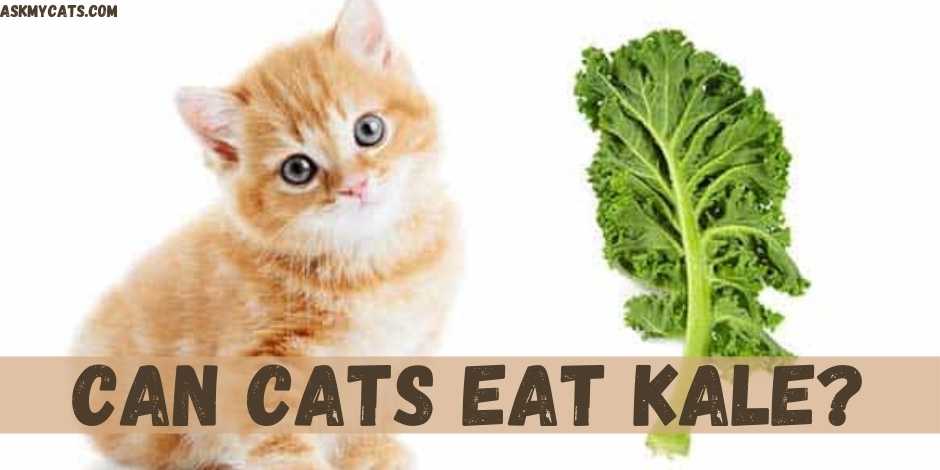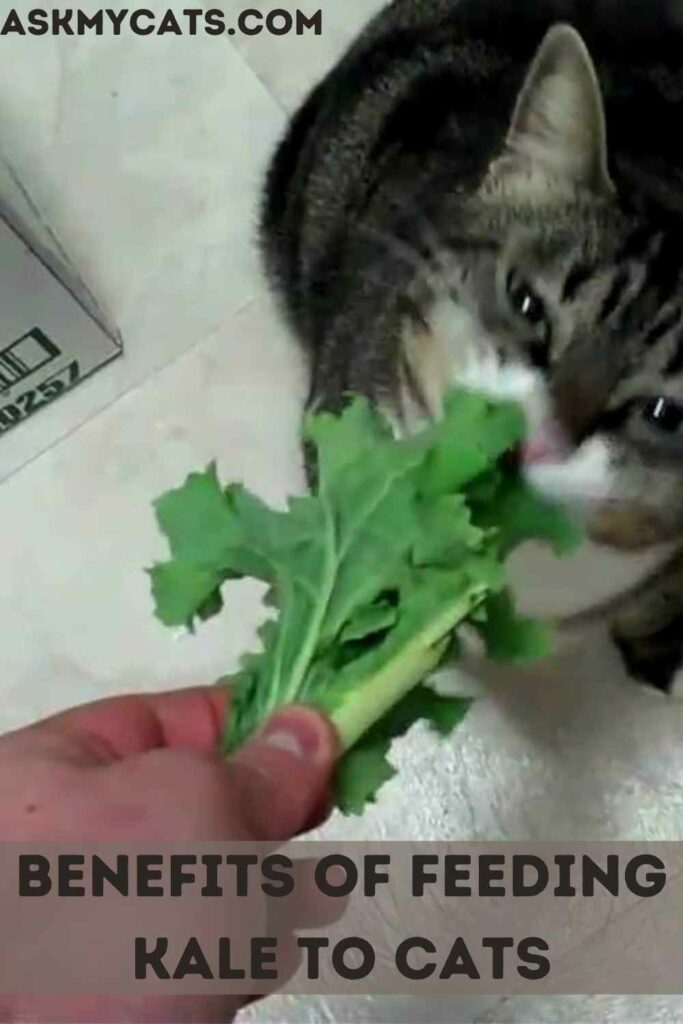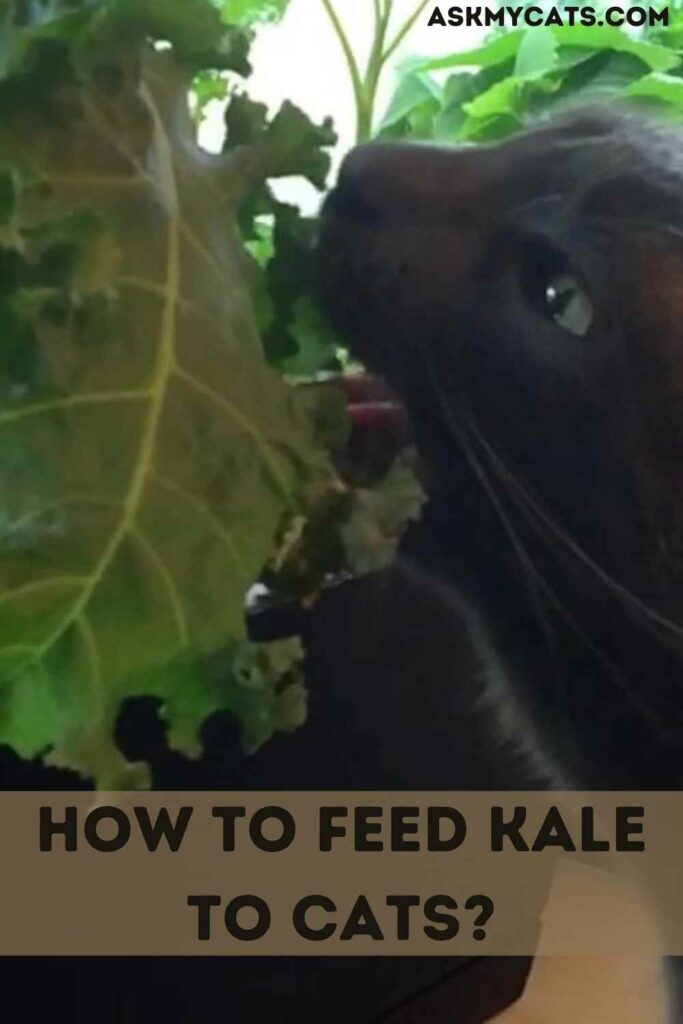Kale is becoming increasingly popular as a superfood, and for good reason. Kale is one of the most nutrient-dense leafy green vegetables available, and it has a low-calorie count, making it a wonderful choice for anyone controlling their weight or attempting to eat more healthily. However, can cats eat kale?
Yes, cats can eat kale. While most veterinarians advise against feeding plant-based foods to cats, kale is one of the few human foods that cats may safely consume. The vegetables are high in fiber, antioxidants, and other critical elements, all of which are beneficial to your cat.
Keeping reading the article to know all the benefits of kale and how much you can feed it to your cat.


Give Your Cat the Perfect Day
Get the Free Ebook!
Is Kale Safe For Cats?
Yes, cats can eat kale as it is non-toxic to them.
Cats are not poisoned by kale. As a result, cats can consume kale. There are several advantages to feeding your cat green leafy vegetables like kale.
But first and foremost, we must comprehend. Our kitties don’t get much nutrition from these human foods. It is not very nutritious for feline companions.
Vegetables provide us with our daily vitamin and mineral requirements. Our cats, on the other hand, are unable to get nutrients from just a vegetarian diet. Carnivores, like housecats, eat meat.
Their food requirements differ from ours.
Kale, broccoli, spinach, and other similar veggies should be combined, according to experts. It’s critical to only offer your cat a minimal amount of greens, as too much kale and other greens might cause health problems for your cat. The first indicators that you gave her too much kale are diarrhea and abdominal distress.
Is Kale Bad For Cats?
Kale can prove to be bad for cats if it is not given in moderation, as cats are carnivores by nature and require meat to stay healthy.
Cats are obligate carnivores who rely on protein for the majority of their nourishment. So, while kale can be beneficial to your cat’s health if served carefully, be sure it’s only a minor component of their overall diet.
Experts believe that if a cat consumes kale, it may get Heinz Body anemia. This is a condition in which red blood cells stop functioning normally.
While you may want to give your cat a tiny bit of kale as a treat or snack on occasion, you should avoid making kale a regular part of their diet.
Is Kale Toxic To Cats?
Kale can become toxic to cats if given too much and can cause kale poisoning.
The main danger of giving your cat too much kale is that they’ll eat it all and then be too full to eat food with the nutrients they require.
Cats adore vegetables, and eating them has certain health benefits, but they are unable to digest many of the nutrients included in them.
Another, more uncommon health hazard might arise from consuming too much kale. It’s called Heinz body anemia, and it causes fever, weakness, loss of appetite, discoloration of the skin and gums, and reddish-brown urine in cats.
Experts say that eating onions or garlic, which are significantly more harmful to cats than kale, is the most common cause of Heinz body anemia. However, consuming too much kale might lead to anemia.
Take your cat to the vet right away if you see any signs. Heinz body anemia is a curable condition, and your cat should be able to return home shortly.
Can Kale Kill A Cat?
No, kale cannot kill a cat as they are non-toxic towards them if fed in moderation.
The general view is that adding kale to your cat’s diet is a good idea. Your feline companion, on the other hand, will not benefit from the minerals and vitamins found in kale in the same manner that humans would.
At max feeding, too much kale to your cat will cause kale poisoning in them. Which can be cured fairly easily.
Is Kale Healthy for Cats?
Kale can prove to be healthy for cats as it can help in maintaining their weight.
Kale can aid in your cat’s weight loss and maintenance. This is significant at a time when more than half of all cats in the United States are overweight.
Fibers have a large bulk but are indigestible. They take up space without adding to the number of calories in a meal. This implies your cat will be able to consume fewer calories.
Adding some high-fiber, low-calorie greens to your cat’s meal will help you limit their caloric intake without leaving them hungry.
Roughage is abundant in kale. This can help your cat’s digestive system function properly. By adding a small amount of kale to your cat’s diet.
You might be able to help prevent indigestion, constipation, gas, and possibly colon cancer by doing so. There aren’t a lot of cat studies out there.
However, dietary fiber has long been linked to a lower risk of diabetes, heart disease, and a variety of malignancies in animals.
Benefits of Feeding Kale To Cats
The benefits of feeding kale to cats include digestion improvement and prevention of diseases.

1. Digestion Improvement
Dietary fiber is abundant in kale, which comprises both soluble and insoluble fibers.
When it comes to boosting the health of your cat’s digestive tract, dietary fiber serves three key roles.
The fiber, for starters, feeds your cat’s gut-friendly microorganisms.
Stomach-friendly bacteria are beneficial bacteria that live in an animal’s gut and help it digest food.
Second, the dietary fiber in kale may help your cat’s feces thicken up.
Fiber helps your cat’s gastrointestinal disorders like indigestion, constipation, diarrhea, and bowel incontinence by bulking up his stool.
Finally, dietary fiber makes you feel fuller for longer. By sprinkling kale over your cat’s regular meal, the cat will consume less food while remaining satisfied for longer.
As a result, you’ll be able to control the amount of food your cat consumes, preventing weight gain.
Dietary fiber has also been linked to enhanced heart and circulatory system functions. The fibers can help your cat’s bloodstream by removing “bad” cholesterol while boosting “healthy” cholesterol.
2. Prevention Of Diseases
Kale is high in antioxidants including beta-carotene, Vitamin C, polyphenols, and flavonoids like quercetin and kaempferol, among others.
These antioxidants protect your cat’s body from oxidative stress caused by free radicals.
In layman’s terms, they keep your cat from developing chronic illnesses like arthritis, cancer, diabetes, and so on.
Antiviral, antifungal, antibacterial, anti-depressant, and anti-inflammatory activities have also been discovered in kale antioxidants. This just goes to show how efficient they are at preventing numerous feline ailments.
Other health benefits of kale include: –
- Can aid in the reduction of blood sugar and cholesterol levels.
- Because of its high vitamin K concentration, it can aid in blood clotting and wound healing.
- Because of its high vitamin A content, it can help your cat’s vision.
- Calcium and potassium are plentiful in kale, which can help your cat’s bones and cells stay healthy.
- Because of the high presence of the antioxidants lutein and zeaxanthins, it can reduce the risk of macular degeneration and cataracts.
- Kale has a good balance of omega-3 and omega-6 fatty acids, making it a good addition to an anti-inflammatory diet.
- Kale is high in antioxidants like beta-carotene, vitamin C, flavonoids, and polyphenols, which help to protect the body from free radical damage.
- Kale is high in lutein and zeaxanthin, nutrients that are linked to a reduced risk of macular degeneration and cataracts.
- Kale includes strong chemicals known as “isothiocyanates,” which assist the body to cleanse while also preventing tumor growth.
Can Cats Benefits From The Nutrients Present In Kale?
Cats will not necessarily benefit from the nutrients present in kale as they are obligate carnivores and derive almost all of their daily minerals and vitamins from a diet of animal protein.

While kale has a strong nutritional profile, the vegetable’s high mineral and vitamin content may not be beneficial to your cat.
It’s crucial to keep in mind that cats are carnivores by nature.
As a result, a meal rich in animal protein provides them with nearly all of their daily minerals and vitamins.
Cats’ bodies are also geared to manufacture some minerals that they would otherwise be unable to receive from their meat-based diet.
Humans, for example, may benefit from the vitamin C found in kales. Cats, on the other hand, can generate this vitamin on their own.
It’s also worth noting that cats have a considerably shorter digestive tract and a different makeup of digestive enzymes than humans.
Above all, all of a cat’s digestive enzymes are designed to break down animal protein.
How To Feed Kale To Cats?
Cats can eat kale both raw and cooked. However, experts emphasize avoiding feeding your cat raw kale.

Kale can be eaten raw or cooked by cats. Experts, on the other hand, advise against eating raw kale for a variety of reasons.
To begin with, raw kale could contain parasites and other microorganisms that could cause gastrointestinal irritation if consumed.
Second, raw kale may contain hazardous aerosol remnants. Ingesting raw kale can cause poisoning if the pesticides and insecticides used to treat the greens were not recognized as pet-safe.
Finally, raw kale poses a risk of choking, especially given that cats do not chew their meal thoroughly.
Still on the subject of choking, make sure you don’t give your cat any kale stems, roots, or other rough pieces.
If you must feed your cat raw kale, make sure to thoroughly wash the vegetables to remove hazardous germs and poisonous aerosol residues. Otherwise, cooked kale is a better option for your kitty companion.
When it comes to cooking, keep in mind that there are a variety of techniques to choose from.
Boiling or steaming the vegetables is the finest way to prepare kale for your cat. The goal is to eliminate all parasites and destroy all hazardous compounds while preserving all nutrients.
When the vegetable is done, serve it to your cat without any salt or condiments. Kale can be served as a stand-alone meal or incorporated into your cat’s usual diet.
Keep the serving sizes small. Keep in mind that this is not a regular meal for your cat.
You might begin by experimenting with tiny amounts of the vegetable two to three times per week. You can change the portions as needed in the future.
Frequently Asked Questions
What are the alternatives to kale?
Ans. If you want to avoid feeding kale to your cat fearing the risk of anemia, you can try other alternatives like Wheatgrass, Wheat/oat grass mixture, Lemongrass, and Barley grass powder.
What greens can cats eat?
Ans. Cats can eat greens like Cabbage, broccoli, cauliflower, radishes, and collard. These belong to the same family as kale. Antioxidants, anti-inflammatory, and cancer-preventive qualities can be found in them. Kale isn’t the only green your cat can consume. Catnip, Cat Thyme, Valerian, Chamomile, Licorice Root, Cat’s Claw, and Goldenseal are all edible to cats. These herbs are not only harmless for cats, but they also aid to improve their health.
Are vegetables harmful to cats?
Ans. No, vegetables are not bad for cats if fed in moderation. Cats do not all like vegetables, and even fewer like fruits this is because felines cannot taste sweet flavors. They are, however, a good source of vitamins and contain a lot of fiber and water, which aids digestion. Steamed broccoli or asparagus, fresh cucumber, or cantaloupe are good for your cat’s health.
Final Words
If you notice your cat chewing on grass or the leaves of your houseplants on a regular basis, it’s likely that they’re doing so to satisfy a dietary need. If that’s the case, you could try incorporating some kale into their diet. It will make your cat more comfortable in the litter box.
If you haven’t seen your cat chowing down on leaves, don’t worry they’re not missing out on anything vital. Cats have excellent instincts and understand what their bodies require. Before you try to put your fuzzy friend on a diet, let them figure out what they need to eat.
If any other questions, feel free to ask us in the comments section.
